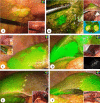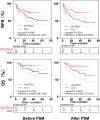Short- and Long-Term Outcomes of Indocyanine Green Fluorescence Navigation- Versus Conventional-Laparoscopic Hepatectomy for Hepatocellular Carcinoma: A Propensity Score-Matched, Retrospective, Cohort Study
- PMID: 36645540
- PMCID: PMC10027802
- DOI: 10.1245/s10434-022-13027-5
Short- and Long-Term Outcomes of Indocyanine Green Fluorescence Navigation- Versus Conventional-Laparoscopic Hepatectomy for Hepatocellular Carcinoma: A Propensity Score-Matched, Retrospective, Cohort Study
Abstract
Background: Indocyanine green (ICG) fluorescence imaging technology is increasingly widely used in laparoscopic hepatectomy. However, whether it can provide long-term survival benefits to patients with liver malignancies remains unclear. This study investigated the clinical effect of laparoscopic hepatectomy for hepatocellular carcinoma (HCC) using ICG imaging technology.
Methods: We retrospectively analyzed HCC patients who underwent laparoscopic hepatectomy at Zhongnan Hospital of Wuhan University from January 2016 to December 2020. Propensity score matching (PSM) was used to match patients undergoing ICG fluorescence navigation laparoscopic hepatectomy (ICG-FNLH) with those undergoing conventional laparoscopic hepatectomy (CLH) in a 1:1 ratio to minimize the influence of confounding factors. We compared perioperative status and long-term prognosis between the two groups and performed multivariate analysis to identify risk factors associated with overall survival and recurrence-free survival.
Results: The original cohort consisted of 141 patients, with 50 patients in each group (100 patients in total) after PSM. The anatomical liver resection rate, R0 resection rate, and resection margin distance in the ICG-FNLH group were higher than those in the CLH group. The intraoperative blood loss was lower than that in the CLH group. The recurrence-free survival and overall survival of the ICG-FNLH group were better than those of the CLH group. ICG-FNLH improved the recurrence-free survival of HCC patients (hazard ratio [HR] = 2.165, 95% confidence interval [CI]: 1.136-4.127, P = 0.024).
Conclusions: Compared with CLH, ICG-FNLH can improve the recurrence-free survival rate of patients with hepatocellular carcinoma and may help to improve the long-term prognosis of patients.
© 2023. The Author(s).
Conflict of interest statement
There are no conflicts of interest for any of the authors.
Figures



Comment in
-
ASO Author Reflections: Indocyanine Green Fluorescence Navigation in Liver Surgery: Current Applications and Future Perspectives.Ann Surg Oncol. 2023 Apr;30(4):2003-2004. doi: 10.1245/s10434-022-13066-y. Epub 2023 Jan 13. Ann Surg Oncol. 2023. PMID: 36637643 Free PMC article. No abstract available.
References
-
- EASL-EORTC clinical practice guidelines: management of hepatocellular carcinoma. J Hepatol. 2012;56(4):908-43. - PubMed
MeSH terms
Substances
Grants and funding
LinkOut - more resources
Full Text Sources
Medical
Miscellaneous

